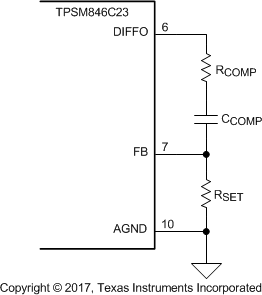ZHCSG68F MARCH 2017 – JANUARY 2019 TPSM846C23
PRODUCTION DATA.
- 1 特性
- 2 应用
- 3 说明
- 4 修订历史记录
- 5 Pin Configuration and Functions
- 6 Specifications
-
7 Detailed Description
- 7.1 Overview
- 7.2 Functional Block Diagram
- 7.3
Feature Description
- 7.3.1 PMBus
- 7.3.2 Minimum Capacitance Requirements
- 7.3.3 Setting the Compensation Network
- 7.3.4 Transient Response
- 7.3.5 Setting the Output Voltage via PMBus
- 7.3.6 Setting the Output Voltage Without PMBus
- 7.3.7 Differential Remote Sense
- 7.3.8 Voltage Reference
- 7.3.9 Switching Frequency and Synchronization
- 7.3.10 Input Undervoltage Lockout (UVLO)
- 7.3.11 Turnon and Turnoff Delay and Sequencing
- 7.3.12 Soft-Start Time and TON_RISE Command
- 7.3.13 Soft-Stop Time and TOFF_FALL Command
- 7.3.14 Prebiased Output Start-Up
- 7.3.15 Power Good (PGOOD) Indicator
- 7.3.16 Linear Regulators BP3 and BP6
- 7.3.17 VREF_TRIM
- 7.3.18 MARGIN
- 7.3.19 Parallel Application
- 7.3.20 Parallel Operation
- 7.3.21 Telemetry
- 7.3.22 Overtemperature Protection
- 7.3.23 Overcurrent Protection
- 7.3.24 Output Overvoltage and Undervoltage Protection
- 7.3.25 Fault Protection Responses
- 7.4 Device Functional Modes
- 7.5
Register Maps
- 7.5.1 OPERATION (01h)
- 7.5.2 ON_OFF_CONFIG (02h)
- 7.5.3 CLEAR_FAULTS (03h)
- 7.5.4 WRITE_PROTECT (10h)
- 7.5.5 STORE_DEFAULT_ALL (11h)
- 7.5.6 RESTORE_DEFAULT_ALL (12h)
- 7.5.7 STORE_USER_ALL (15h)
- 7.5.8 RESTORE_USER_ALL (16h)
- 7.5.9 CAPABILITY (19h)
- 7.5.10 SMBALERT_MASK (1Bh)
- 7.5.11 VOUT_MODE (20h)
- 7.5.12 VOUT_COMMAND (21h)
- 7.5.13 VOUT_MAX (24h)
- 7.5.14 VOUT_TRANSITION_RATE (27h)
- 7.5.15 VOUT_SCALE_LOOP (29h)
- 7.5.16 VOUT_MIN (2Bh)
- 7.5.17 VIN_ON (35h)
- 7.5.18 VIN_OFF (36h)
- 7.5.19 IOUT_CAL_OFFSET (39h)
- 7.5.20 VOUT_OV_FAULT_RESPONSE (41h)
- 7.5.21 VOUT_UV_FAULT_RESPONSE (45h)
- 7.5.22 IOUT_OC_FAULT_LIMIT (46h)
- 7.5.23 IOUT_OC_FAULT_RESPONSE (47h)
- 7.5.24 IOUT_OC_WARN_LIMIT (4Ah)
- 7.5.25 OT_FAULT_LIMIT (4Fh)
- 7.5.26 OT_FAULT_RESPONSE (50h)
- 7.5.27 OT_WARN_LIMIT (51h)
- 7.5.28 TON_DELAY (60h)
- 7.5.29 TON_RISE (61h)
- 7.5.30 TON_MAX_FAULT_LIMIT (62h)
- 7.5.31 TON_MAX_FAULT_RESPONSE (63h)
- 7.5.32 TOFF_DELAY (64h)
- 7.5.33 TOFF_FALL (65h)
- 7.5.34 STATUS_BYTE (78h)
- 7.5.35 STATUS_WORD (79h)
- 7.5.36 STATUS_VOUT (7Ah)
- 7.5.37 STATUS_IOUT (7Bh)
- 7.5.38 STATUS_INPUT (7Ch)
- 7.5.39 STATUS_TEMPERATURE (7Dh)
- 7.5.40 STATUS_CML (7Eh)
- 7.5.41 STATUS_MFR_SPECIFIC (80h)
- 7.5.42 READ_VOUT (8Bh)
- 7.5.43 READ_IOUT (8Ch)
- 7.5.44 READ_TEMPERATURE_1 (8Dh)
- 7.5.45 PMBUS_REVISION (98h)
- 7.5.46 IC_DEVICE_ID (ADh)
- 7.5.47 IC_DEVICE_REV (AEh)
- 7.5.48 MFR_SPECIFIC_00 (D0h)
- 7.5.49 VREF_TRIM (MFR_SPECIFIC_04) (D4h)
- 7.5.50 STEP_VREF_MARGIN_HIGH (MFR_SPECIFIC_05) (D5h)
- 7.5.51 STEP_VREF_MARGIN_LOW (MFR_SPECIFIC_06) (D6h)
- 7.5.52 PCT_OV_UV_WRN_FLT_LIMITS (MFR_SPECIFIC_07) (D7h)
- 7.5.53 OPTIONS (MFR_SPECIFIC_21) (E5h)
- 7.5.54 MISC_CONFIG_OPTIONS (MFR_SPECIFIC_32) (F0h)
- 8 Application and Implementation
- 9 Power Supply Recommendations
- 10Layout
- 11器件和文档支持
- 12机械、封装和可订购信息
7.3.5 Setting the Output Voltage via PMBus
The output voltage of the TPSM846C23 is designed to be set via the PMBus using the VOUT_COMMAND (21h). The output voltage is also dependant on the value of VOUT_SCALE_LOOP (29h) and the presence of a resistor, RSET, from the FB pin (pin 7) to AGND. Table 5 illustrates the possible combinations. The module is programmed at the factory for a VOUT_SCALE_LOOP value of 1 and a VOUT_COMMAND value of 256 (100h), which produces an output voltage of 0.500 V.
Table 5. VOUT_SCALE_LOOP and Output Voltage Range
| VOUT_SCALE_LOOP | RSET VALUE | OUTPUT VOLTAGE RANGE (V) | VOUT_COMMAND
DATA VALID RANGE |
||
|---|---|---|---|---|---|
| MIN | MAX | MIN (Hex) | MAX (Hex) | ||
| 1 | Not required | 0.35 | 1.65 | 179 (0B3h) | 845 (34Dh) |
| 0.5 | 10 kΩ, 1% | 0.7 | 2(1) | 358 (166h) | 1024 (400h) |
The output voltage is set by writing a value with the PMBus VOUT_COMMAND (21h). The VOUT_COMMAND value can be calculated using Equation 1, (round to the nearest integer value), and then converted to a 16 bit hexadecimal value. Using the Write Word protocol, write the hexadecimal word to the device using the VOUT_COMMAND.
The value written using the VOUT_COMMAND is held in RAM and remains until it is re-written with a new value or if power is removed. If power is removed and then reapplied, the output voltage and the value in the VOUT_COMMAND register are restored to the value stored in the non-volatile memory of the device. To save the VOUT_COMMAND value to non-volatile memory and make it the new default value, issue the STORE_DEFAULT_ALL command.
For output voltages ≤ 1.65 V, RSET is not required. If an output voltage greater than 1.65 V is required, a 10-kΩ RSET resistor must be populated. See Figure 15 for the proper connection of RSET.
This device is electrically and thermally characterized up to a maximum of 2-V output, and a maximum of 70-W output power. Operation at higher output voltages may be possible, provided the maximum output power and other internal parameters are not exceeded. Higher output voltages require derating to the output current and may require higher switching frequencies. Consult the TI factory applications engineers for support.
 Figure 15. RSET Resistor
Figure 15. RSET Resistor